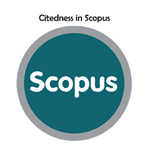Formulating Oil Emulgel of Nyamplung (Calophyllum inophyllum L) with Variations of HPMC and Activity Testing for Incision in Rabbit New Zealand
Abstract
Keywords
Full Text:
PDFReferences
R. Putrianirma, N. Triakoso, M. N. Yunita, I. S. Yudaniayanti, I. S. Hamid, and F. Fikri, "Efektivitas Ekstrak Daun Afrika (Vernonia amygdalina) Secara Topikal Untuk Reepitelisasi Penyembuhan Luka Insisi Pada Tikus Putih (Rattus novergicus)" J Med Vet, vol. 2, no. 1, pp. 30-5, 2019. https://doi.org/10.20473/jmv.vol2.iss1.2019.30-35
A. C. Dweck and T. Meadows, "Tamanu (Calophyllum inophyllum)-the African, Asian, polynesian and pacific panacea" International journal of cosmetic science, vol. 24, no. 6, pp. 341-348, 2002. https://doi.org/10.1046/j.1467-2494.2002.00160.x
J.-L. Ansel et al., "Biological activity of Polynesian Calophyllum inophyllum oil extract on human skin cells" Planta medica, vol. 82, no. 11/12, pp. 961-966, 2016. https://doi.org/10.1055/s-0042-108205
A. Alexander, A. Khichariya, S. Gupta, R. J. Patel, T. K. Giri, and D. K. Tripathi, "Recent expansions in an emergent novel drug delivery technology: Emulgel" Journal of Controlled Release, vol. 171, no. 2, pp. 122-132, 2013. https://doi.org/10.1016/j.jconrel.2013.06.030
H. Nursiah and G. A. Faradiba, "Formulasi Gel Sari Buah Belimbing Wuluh (Averrboa bilim L.), Universitas Hasanuddin dan Universitas Muslim Indonesia Makassar" Majalah Farmasi dan Farmakologi, vol. 15, no. 1, pp. 5-9, 2011.
A. S. Wiyono, T. P. Lestari, and V. S. Wardani, "Pengaruh HPMC Sebagai Gelling Agent Pada Optimasi Formula Gel Ekstrak Kasar Bromelin Kulit Nanas (Ananas comossus L. Merr):-" Jurnal Sintesis: Penelitian Sains, Terapan dan Analisisnya, vol. 1, no. 2, pp. 52-59, 2020.
A. Fauziah, I. Mulyani, and R. N. Ramdhini, "FORMULASI DAN EVALUASI FISIK SAMPO ANTIOKSIDAN DARI EKSTRAK UBI JALAR UNGU (Ipomoea Batatas L.)" JFL: Jurnal Farmasi Lampung, vol. 10, no. 1, pp. 1-10, 2021. https://doi.org/10.37090/jfl.v10i1.495
M. Heinrich, J. Barnes, S. Gibbons, and E. M. Williamson, "Farmakognosi dan Fisioterapi (terj.)" Jakarta: EGC, pp. 82-212, 2010.
R. I. Depkes, "Farmakope Indonesia ed V" Jakarta: Depkes RI, 2014.
N. S. Daud and E. Suryanti, "Formulasi Emulgel Antijerawat Minyak Nilam (Patchouli oil) Menggunakan Tween 80 dan Span 80 sebagai Pengemulsi dan HPMC sebagai Basis Gel" Jurnal Mandala Pharmacon Indonesia, vol. 3, no. 02, pp. 90-95, 2017. https://doi.org/10.35311/jmpi.v3i02.3
P. O. M. Ditjen, "Formularium Kosmetika Indonesia" Jakarta: Departemen Kesehatan RI. Hal, vol. 83, no. 85, pp. 106-132, 1985.
N. A. Safitri, O. E. Puspita, and V. Yurina, "Optimasi formula sediaan krim ekstrak stroberi (Fragaria x ananassa) sebagai krim anti penuaan" Majalah kesehatan FKUB, vol. 1, no. 4, pp. 235-246, 2016.
A. N. Aisyah and N. A. Y. Zulham, "Formulation of Emulgel Ethanol Extract of Mullberry (Morus alba L.) with Various Concentration of Span 80® and Tween 80®" Journal of Pharmaceutical and Medicinal Sciences, vol. 2, no. 2, pp. 77-80, 2017.
N. Sinata and A. Mistawati, "Formulasi dan uji aktivitas emulgel minyak ikan gabus (Channa striata) sebagai penyembuh luka bakar" Jurnal Farmasi Galenika (Galenika Journal of Pharmacy)(e-Journal), vol. 6, no. 2, 2020. https://doi.org/10.22487/j24428744.2020.v6.i2.15013
S. Megawati, U. C. Ummah, and A. A. Setiawan, "Formulasi Dan Uji Efektivitas Penyembuhan Luka Sayat Salep Ekstrak Metanol Bunga Ginje (Thevetia Peruviana) Terhadap Kelinci Jantan New Zealand White" Jurnal Farmasi Udayana, pp. 180-186, 2020. https://doi.org/10.24843/JFU.2020.v09.i03.p06
P. Raharivelomanana et al., "Tamanu oil and skin active properties: from traditional to modern cosmetic uses" Ocl-Oilseeds and Fats Crops and Lipids, vol. 25, no. 5, 2018. https://doi.org/10.1051/ocl/2018048
S. Rejeki and S. S. Wahyuningsih, "Formulasi gel tabir surya minyak nyamplung (Tamanu Oil) dan uji nilai SPF secara in vitro" 2015.
D. Suhendra, A. Solehah, D. Asnawati, and E. R. Gunawan, "Sintesis poliuretan dari asam lemak teroksidasi minyak inti buah nyamplung melalui proses polimerisasi menggunakan toluen diisosianat" Chemistry Progress, vol. 6, no. 2, 2019. https://doi.org/10.35799/cp.6.2.2013.3496
D. Sumarna, "Studi Metode Pengolahan Minyak Sawit Merah (Red Palm Oil) dari Crude Palm Oil (CPO)" 2014.
L. Nurdianti, "Evaluasi sediaan emulgel anti jerawat tea tree (Melaleuca alternifolia) oil dengan menggunakan hpmc sebagai gelling agent" Journal of Pharmacopolium, vol. 1, no. 1, 2018. http://dx.doi.org/10.36465/jop.v1i1.392
H. S. Zein and M. Murrukmihadi, "Pengaruh Konsentrasi HPMC sebagai Gelling Agent terhadap Sifat Fisik dan Stabilitas Gel Ekstrak Etanol Daun Ubi Jalar (Ipomoea batatas L.)" Media Farmasi Indonesia, vol. 9, no. 2, 2014.
A. L. Yusuf, E. Nurawaliah, and N. Harun, "Uji efektivitas gel ekstrak etanol daun kelor (Moringa oleifera L.) sebagai antijamur Malassezia furfur" Kartika: Jurnal Ilmiah Farmasi, vol. 5, no. 2, pp. 62-67, 2017. http://dx.doi.org/10.26874/kjif.v5i2.130
S. Nur, J. A. Baitanu, and S. A. Gani, "Pengaruh tempat tumbuh dan lama penyulingan secara hidrodestilasi terhadap rendemen dan profil kandungan kimia minyak atsiri daun kemangi (Ocimum canum Sims L.)" Jurnal Fitofarmaka Indonesia, vol. 6, no. 2, pp. 363-367, 2019. https://doi.org/10.33096/jffi.v6i2.507
M. H. Malaka, A. Indalifiany, S. Sahidin, A. Fristiohady, and R. Andriani, "FORMULATION AND PHYSICAL STABILITY TEST OF NANOEMULGEL CONTAINING Petrosia Sp. ETHANOLIC EXTRACT" 1, vol. 7, no. 3, Art. no. 3, 2021, https://doi.org/10.31603/pharmacy.v7i3.6080.
I. D. K. Irianto, P. Purwanto, and M. T. Mardan, "Aktivitas Antibakteri dan Uji Sifat Fisik Sediaan Gel Dekokta Sirih Hijau (Piper betle L.) Sebagai Alternatif Pengobatan Mastitis Sapi" Majalah Farmaseutik, vol. 16, no. 2, Art. no. 2, Jun. 2020, https://doi.org/10.22146/farmaseutik.v16i2.53793.
DOI: https://doi.org/10.37311/ijpe.v2i3.15455
Refbacks
- There are currently no refbacks.
Copyright (c) 2022 Erinda Risma Puspita Cahya, Dewi Ekowati, Dwi Ningsih

Indonesian Journal of Pharmaceutical Education is licensed under a Creative Commons Attribution-NonCommercial-ShareAlike 4.0 International License.



